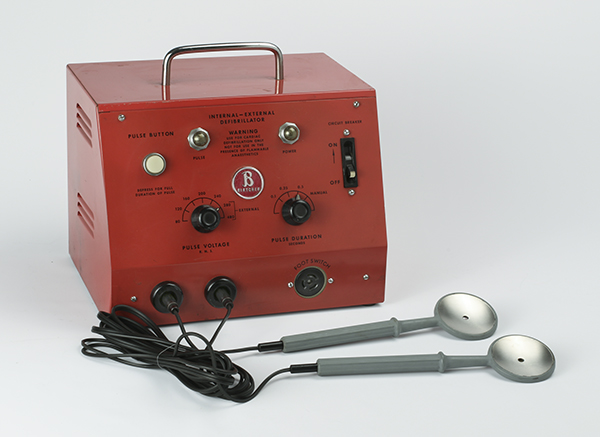Heart attack, or cardiac arrest, became a leading cause of death after the turn of the century. People had always suffered from cardiac problems, but they usually died from other causes, especially infectious diseases, long before reaching the age when heart problems threatened their well being. As medicine advanced and people lived longer, heart disease became a serious health issue. Today, of course, we think of it as one of the United States’ top “killers”–and most are familiar with defibrillation “paddles” and the command “Clear!” But did you know that the defibrillator began here in Cleveland? Claude Beck (1894-1971) pioneered heart surgery, especially operations to improve circulation in damaged heart muscles. He also devised ways to revive heart attack victims with the use of carefully controlled electricity, or “defibrillation.
Claude Beck: Developer of the first heart defibrillator in Cleveland, Ohio.
Beck trained at Johns Hopkins and joined University Hospitals Case Medical Center in 1924 as resident and Crile Research Fellow in Surgery. While performing cardiac surgery in Cleveland, Beck noted that the heart sometimes went into “ventricular fibrillation.” This means the heart muscles twitched and contracted rapidly, disrupting the normal rhythmic heartbeat. Beck could massage the heart, but this did not always stop the fibrillation and the patient would die on the operating table. Desperate for a remedy, he learned that a colleague at Western Reserve, the physiologist Carl J. Wiggers, had maintained circulation in laboratory animals by manual massage followed by electrical shock. Excited by this idea, Beck went to work–and in 1947 he successfully revived a patient for the first time with his “defibrillator.” His device saved many lives, and Beck had more to offer. He spent his life working under Dr. Harvey Cushing and with other cardiovascular “greats” like Elliott Cutler and Donald Eiffler to change the future for heart patients.
Did You Know that CPR is CLEVELAND PROUD?
The defibrillator isn’t Cleveland’s only cardiac first. With the help of the Cleveland Heart Society, Beck and colleagues developed cardiopulmonary resuscitation (CPR) techniques. In less than twenty years, they trained more than 3,000 doctors and nurses. Dr. Beck later created a short teaching film in which he introduced a group of 11 patients who were successfully resuscitated, and in 1963, he and colleagues added a course in closed-chest cardiopulmonary resuscitation for lay persons. Beck created 16mm films to aid in training new CPR practitioners; these films provided images, diagrams, demonstrations, and even interviews with survivors!
Big Risks and Big Pay-offs
Sometimes medicine really is “practice.” With the first heart surgeries, the future was uncertain. How far could we meddle with this delicate organ? The “Beck I” surgery involved a technique for increasing circulation of blood to the myocardium by inducing adhesions between the heart and the pericardium through various methods including sutures. While seemingly damaging to the heart, the adhesions resulted in more muscle contact, so more blood could be available to the heart. “The Beck II” surgery went further by creating a vein graft between the Aorta and Coronary Sinus, pioneering revascularization of the heart. The first Beck I surgery on a human being took place in 1935, and the Beck II in the late 1940s. But the introduction of machines like the Kay-Cross Oxygenator pushed surgery even further by circulating blood for the patient even when the heart was stopped!
A team of cardiac physicians and specialists (including Kolff, Effler, and Sones) performed the first stopped-heart surgery in Cleveland for bypass surgery. Another Cleveland doctor, Rene Favaloro, would establish the standard technique for the procedure at Cleveland Clinic, and it would soon be repeated successfully in other hospitals across the United States. With the introduction of coronary arteriography (where the doctor could see live moving images of the heart) by Mason Sones in 1958, doctors could directly treat coronary blockage. Then, in 1968, Dr. Effler and his colleagues performed the first cardiac transplant in the Midwest!
These doctors took great risks, and not every surgery could be successful. Even so, great strides were made, and Cleveland remains a center for heart disease treatment—much of it made possible by the introduction of the Beck defibrillator for restarting a stopped heart.


